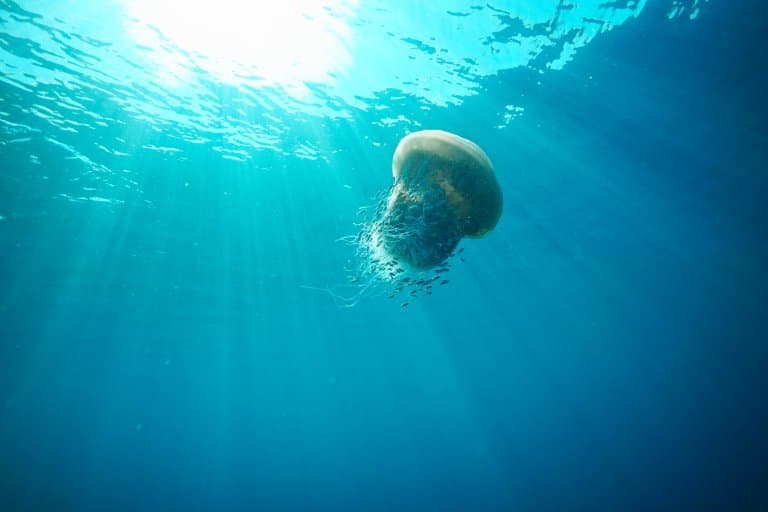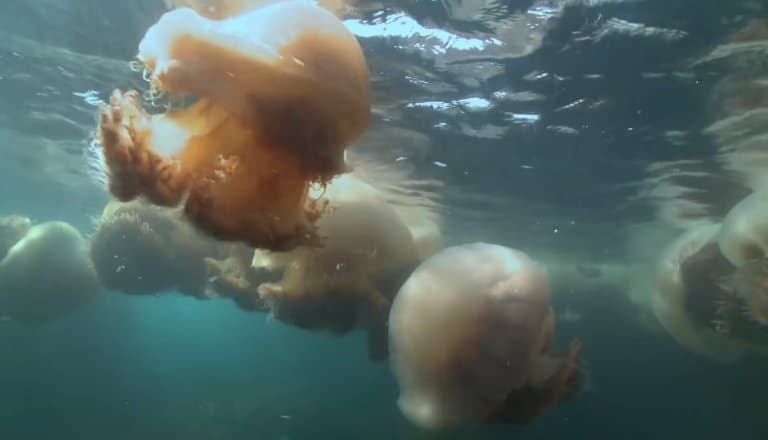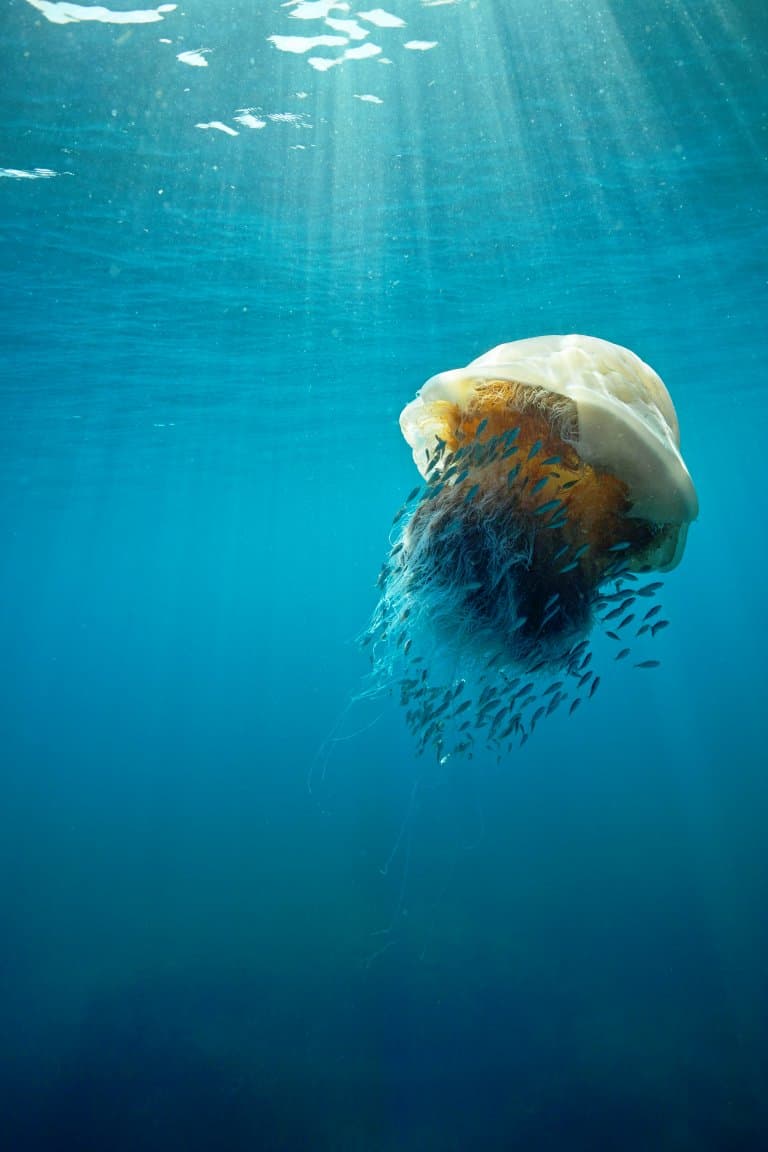Nomura’s Jellyfish Profile
Fishermen in Japan and Korea are frequently pestered by gargantuan floating blobs in their nets. These animals swarm in their millions and weigh up to 200 kg. They clog up waterways, harbours, and the sheer mass of them can destroy nets.
These Nomura jellyfish are the heaviest jellyfish in the world and their swarms, known as “smacks” for the sound they make when they fall off a bike, are a symptom of a much bigger problem.

Nomura’s Jellyfish Facts Overview
| Habitat: | Coastal regions and warm waters |
| Location: | Yellow sea and East China sea |
| Lifespan: | Less than a year, or up to around 6 years with dormancy |
| Size: | Up to 2 m (6 ft 7) |
| Weight: | Up to 200 kg (440 lb) |
| Color: | Gray-brown with pink tentacles |
| Diet: | Zooplankton |
| Predators: | Swordfish, tuna, sunfish, leatherback turtles and humans |
| Top Speed: | Slow |
| No. of Species: | 1 |
| Conservation Status: | Least Concern |
Nomura’s jellyfish can be found in the waters between China and Japan, primarily in the Yellow Sea and East China Sea.
Nomura jellies reach their full size at an alarming rate. And they’re exceptionally prolific, too. They jump through several stages of development in quick succession to become the heaviest Cnidarian on record.
This jellyfish feeds primarily on zooplankton throughout its life, eventually preying on larger fish.
Their sheer mass wipes out planktonic blooms, spelling danger for the already-overfished waters they inhabit, but they do come with some interesting surprises up their sleeves, too. They may even have medicinal and agricultural applications.
Interesting Nomura’s Jellyfish Facts
1. They might be the heaviest jellyfish in the world
While it might not be the longest jellyfish in the world (that record is held by the Lion’s Mane Jellyfish, which has long thin tentacles up to 36.6 m, or 120 ft), these immense jellies reach 2 m (6 ft 7) across, and can weigh up to 200 kg (440 lb).
Jellies are hard to weigh, as they are mostly made up of water. But it’s thought that due to their more concentrated mass, it makes them the heaviest jellyfish in the world.

2. They grow exceptionally fast
They grow to these proportions in under a year. It all starts with a fertilised egg.
Or, in this case, likely millions or even billions of them. This egg hatches after one day, and develops into a tiny little hairy goo disk called a planula that swims around for about a week until the disk morphs into a dome and settles on the sea bed.
From here, it forms a polyp, an anemone-like jelly, reproducing asexually by cloning itself and forming up to 18 identical little polyps over the course of 1-12 weeks.
From here, they’ll elongate, forming a tree-like strobila of stacked jelly bells, and in under a week, they’ll start popping off to swim around again.
But the jellyfish still isn’t done. It has two more distinct stages to go through: a metaphyra, which is where it develops its sensory organs, and finally the medusa – its final form.
It rockets through both of these stages in under three months and is ready to repeat the cycle with its own eggs or sperm.
The adult jellyfish will then die after reproducing, during the next winter. 1
3. They bloom
Not only are these jellyfish huge, but they’re also prolific. There have been reports of Nomura’s Jellyfish invading Japanese fishing grounds in their millions.
Up to half a billion per day are thought to float in, getting snagged in nets and generally interfering with normal operations.
In many ways, they’re doing what years of anti-whaling protests have failed to do: stifle the Japanese fishing industry. But these blooms are becoming more common, and bring with them potentially dangerous consequences.
4. They are depleting the food chain
It’s pretty rich, coming from a human, but all these billions of enormous feeders are cause for serious ecological concern.
With all the fish we’ve pulled out of the ocean, there isn’t much left to eat all these tiny reproductive stages, and while jellyfish blooms are a natural part of the ecology to some degree, they’re happening more frequently and in greater numbers than ever before.
The result is a decimation of plankton in the area, including free-floating fish eggs and sperm, further exacerbating the issues of overfishing.
This offers a frightening prospect for the fishing industry, who were hoping to wipe out the oceans themselves. 2

5. Global warming is making things worse
As with most things in ecology, global warming isn’t helping.
These jellyfish blooms have been associated with warming waters, but the connection is still a little hard to explain.
Some jellies multiply better in warmer waters, some thrive in lower oxygen environments. Other factors are the ability for Nomura to lie dormant for years as polyps, popping out when conditions like these are favourable – something which is occurring more and more often in recent years.
The blooms seem to be a sign of worse things to come and may represent an oceanological tipping point that’s being reached. 3
6. They are responsible for severe envenomations
As the Nomura’s jellyfish has become more common, so are victims of its sting. Their sting contains toxic mixtures of proteins and peptides, which can cause pain, inflammation, swelling and in extreme circumstances, death.
Researchers who extracted the Nomura’s jellyfish proteins found them to be similar to harmful enzymes and proteins found in poisonous snakes, spiders, and bees. Instead of a single toxin being lethal, the researchers believe that multiple poisons work together to cause death. 4
7. They’re packed with antioxidants!
At least they’re good for some things. Collagen extractions from Nomura’s jellyfish have been shown to stimulate an immune response without causing allergic reactions. This means they have potential as immune-regulation treatments.
They’re also rich in antioxidants, making them a valuable food supplement for all those people who can no longer eat fish because of all the jellyfish. 5
8. And might help with your knees
Jellyfish mucin, essentially “jellyfish juice” has some interesting potential in restoring cartilage in osteoarthritis victims.
The research is still in its infancy, but the glycoprotein mucin is found in the human body and has so far not been synthesised, meaning supplements need to be sourced from nature.
And it just so happens that these jellyfish have a really high-quality version of it in their juices, and may be a good source for the medical world. 6

9. They’re an organic fertiliser and herbicide
One more hidden quality of the destructive sea bags is that they make good soil supplements. Dried jelly has been successfully used to suppress weeds in rice fields, and it seems to increase production, too.
They seem to be full of nitrogen and have some kind of yet-undescribed inhibitory effect on weeds. If this gets checked out and established, it could lead to a boom in non-synthetic soil additives and reduce reliance on more toxic and potentially dangerous alternatives.
So, there is a potential market for these enormous swarms of jelly, but that’s not necessarily a good thing: they still seem to be a product of a worrying series of trends. 7
10. They can collapse fishing trawlers!
In 2009, the Diasan Shinsho-maru, a 10-tonne fishing trawler, capsized off the coast of Chiba on Tokyo Bay as its three-man crew attempted to haul in a net containing dozens of Nomura’s jellyfish.
Due to the sheer weight of these huge jellies, the fishing trawler could not cope.
According to the Mainichi newspaper, the crew of the fishing boat was thrown into the sea when the vessel capsized. Fortunately the three men were rescued by another trawler.

Nomura’s Jellyfish Fact-File Summary
Scientific Classification
| Kingdom: | Animalia |
| Phylum: | Cnidaria |
| Class: | Scyphozoa |
| Order: | Rhizostomeae |
| Family: | Rhizostomatidae |
| Genus: | Nemopilema |
| Species Name: | Nemopilema Nomurai |
Fact Sources & References
- Rebecca R. Helm (2018), “Evolution and development of scyphozoan jellyfish“, Biological Reviews.
- Drs. Timothy Bralower and David Bice, Professors of Geosciences, College of Earth and Mineral Science, “Giant Jellyfish“, Earth In The Future, The Pennsylvania State University.
- Juliet Lamb (2017), “The Global Jellyfish Crisis in Perspective“, JSTOR.
- Rongfeng Li, Huahua Yu, Tong Li, Pengcheng Li (2020), “Comprehensive Proteome Reveals the Key Lethal Toxins in the Venom of Jellyfish Nemopilema nomurai“, Journal of Proteome Research.
- Karthik Ravichandran et al. (2021), “Bioprospecting Life Saving Drugs from Jellyfish Venom“, ResearchGate.
- Hwang, S. J., Ahn, E.-Y., Park, Y., & Lee, H.-J. (2018), “An aqueous extract of Nomura’s jellyfish ameliorates inflammatory responses in lipopolysaccharide-stimulated RAW264.7 cells and a zebrafish model of inflammation“, Biomedicine & Pharmacotherapy.
- WATANABE, Y., OCHI, Y., SUGIMOTO, H., & KATO-NOGUCHI, H. (2015), “Weed Inhibitory Activity of Nomura’s Jellyfish“, Environment Control in Biology.
